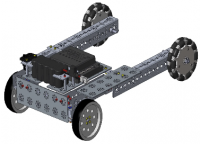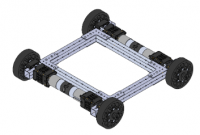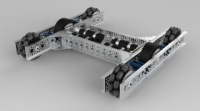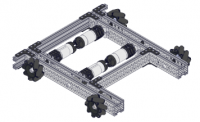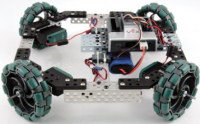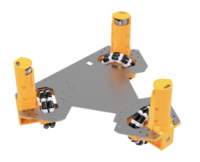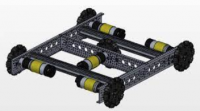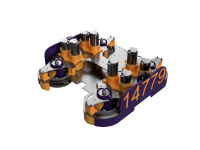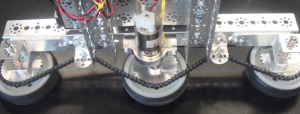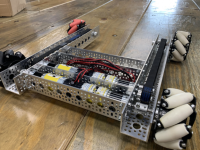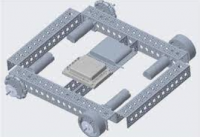FTC:Drivetrain
Drivetrain
In FIRST Tech Challenge, the drivetrain refers to the part of the robot that allows it to move around the field. It is mainly composed of motors, wheels, and a chassis to hold all these things and other subsystems together. By combining these three things together in different ways, many different types of drivetrains can be made.
Types of Drivetrains
| Name | What Is It | Pros | Cons |
| 2-Wheel | A two-wheel drivetrain consists of two moving wheels and two non-moving wheels. The design can have moving wheels in the front or the back, but they should be across from each other. |
|
|
| 4-Wheel | It has 4 wheels that are moving. This method can use 2 or 4 motors depending on the driver’s preference or how many motors subsystems will need. |
|
|
| 6-Wheel | Very similar to the 4-wheel drivetrain, however, each side has 3 wheels. |
|
|
| Tank | A tank drivetrain uses treads powered by 1-2 motors on each side. |
|
|
| Mecanum | This drivetrain requires mecanum wheels and 4 motors to work. The special wheels need to spin in different directions in order for the robot to strafe. |
|
|
| Holonomic | Similar to the mecanum drivetrain except the wheels are oriented at 45° angles on the corner of the robot. This drivetrain uses Omni wheels orientated this way to allow good control over the robot. |
|
|
| Kiwi | A triangular-shaped drivetrain that has Omni wheels on the corner (at 60° angles) or the side of the robot. |
|
|
| H-Drive | This type of drivetrain has a basic 4-wheel drivetrain with Omni wheels. However, in the center are 1-2 perpendicular wheels that allow the robot to strafe. These wheels need suspension if the field uses rough terrain. |
|
|
| Swerve | Swerve Drive are a unique type of drivetrain that can be very strong in defense. THey have multiple pods that are able to rotate independently of each other providing good maneuverability while maintaining high strength and defensibility. |
|
|
There are also many different kits that most major FIRST part vendors will sell. These are typically very simple and easy to use, however, not very customizable.
Motors
| Name | Uses | Pros | Cons |
| NeveRest Orbital 20 Gearmotor | Good for use in high-speed drivetrains |
|
|
| NeveRest 40 | Good for use in driving |
|
|
| REV Ultra Planetary Gearmotor | High-speed subsystems and driving |
|
|
| REV HD Hex Motor 20:1 Planetary | High-speed subsystems and driving |
|
|
| REV HD Hex Motor 40:1 | Good for driving and for high torque subsystems |
|
|
| goBilda 5202 Series Yellow Jacket Planetary Gear Motor | Good for subsystems and driving. It can be put into a goBilda U-channel |
|
|
| goBilda 5203 Series Yellow Jacket Planetary Gear Motor | Good for subsystems and driving. It can be put into a goBilda U-channel |
|
|
Wheels
Wheels are what your robot sits on. Using certain wheels enables different types of motion. Remember that the robot doesn’t have to have all the same types of wheels. Get creative with how wheels can be used to advantage the team.
| Name | Pros | Cons |
| Mecanum |
|
|
| Omni Wheel |
|
|
| Stealth Wheel |
|
|
If you want to learn more, here is a quick video we made that covers the wheels in more depth.
Chassis
The chassis is the base to support everything, including subsystems, on the robot. The motors and wheels are attached onto the chassis in order to move it around. It is mainly composed of strong support beams or plates connected together to form a strong base for a robot. There are many different part providers that provide the necessary parts for a chassis. There are even some kits for this.
Ways to Power the Types of Drivetrains
There are many different ways to connect wheels to motors in FTC. These types of connections, or drives, can be used to amplify power/torque or speed.
| Name | What Is It | Pros | Cons |
| Bevel Gears | Two perpendicular gears that turn against each other. An axle is connected to each bevel gear. One axle leads to the wheels and one leads to the motor. The motor powers one gear to spin, turning the other one, therefore, turning the wheel. |
|
|
| Chains | Two sprockets are connected together by a chain with a motor at one end. The other end has the wheel that spins with the motor. This motor is connected to a sprocket that powers the whole system. The other sprocket is connected to the wheel so it can turn and an optional sprocket can be placed in between these two to tension the chain. This tension prevents the chains from slipping off. |
|
|
| Belts | This system is very similar to a chain drive except it uses belts instead of chains. Also, It doesn’t always need an additional sprocket or wheel to keep it tensioned. If it uses stretchy belts this is unnecessary. |
|
|
| Direct Drive | The motor is connected directly to the wheel and spins with it. |
|
|
